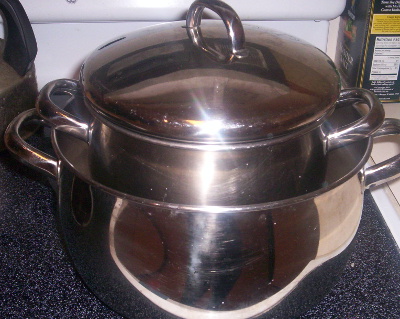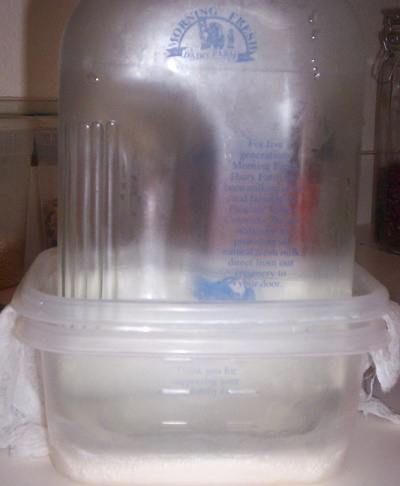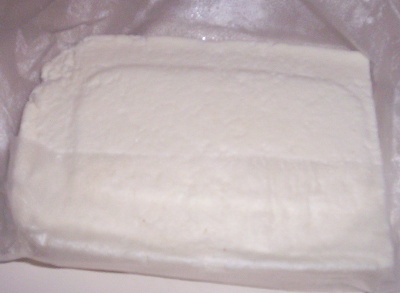


painless paneer and a fictionette freebie
Wed 2015-07-01 23:53:35 (in context)
- 1,571 words (if poetry, lines) long
I've got more recipes to share! Why? Because I win at leftovers, and that is a fine, fine feeling.
I've also got this month's Fictionette Freebie for everybody. I decided on "You Could Go a Long Way in Shoes Like Those" because I think it's funny and I wanted to show it off in full. You can download the PDF ebooklet or the MP3 audiofictionette, be you subscriber or no, just as you please. Enjoy!
OK, so. Recipes! Here we go. Today, it's How to Make Paneer Without Making a Mess.
This is not originally my recipe. It isn't even a recipe, no more than instructions on how to turn cream into butter is a recipe. (Step 1: Put heavy whipping cream in a sealed container. Step 2: Shake container until the contents are no longer sloshing. You've got whipped cream. Step 3: Shake container some more until contents are sloshing again. You've got butter and buttermilk.) Paneer is just a form of fresh house cheese, which is to say, curds separated out of milk. You can find out how to make it on the internet. So did I! I follow the instructions linked from a Tea & Cookies blog post from June 2007. (I also use the Tea & Cookies recipe for saag paneer. It's the best.)
But I have also developed a method that makes it less of a pain in my butt.
But first--why do I make paneer when I can easily buy it in the store? Well, for one thing, it's very satisfying to make my own. For another, I'm terribly prone to letting the better part of a half-gallon of milk go to waste. I do not want to waste milk! Thus I make cheese.
The main innovation: I no longer boil the milk in a pot over direct heat. I got heartily sick of scraping burnt milk solids off the pan when I was done, see. Now I take my biggest stainless steel pot, and I fill it with enough water such that when I nest the next biggest pot inside it, the nested pot's bottom is only barely submerged. Milk goes in the nested pot, of course, with a lid on top to keep the heat in. Then I turn the heat to full boil and I just walk away.
Well, not too far. But from my desk in the office I can easily hear when the water in the big pot reaches full boil. It sounds weirdly like footsteps. The milk, meanwhile, not being over direct heat, isn't quite so prone to froth over and make a mess on the stove. It will also leave no worse mess in the pot than a ring of (unburnt) curd crumbs that I can knock off in seconds with a sponge.
(Caution: If water keeps slopping over the side once it's boiling, take the milk pot out of the boiler pot, then take a sturdy coffee mug and scoop out about half a cup of water. Replace the milk pot. Repeat until water no longer slops over the side.)
Milk reaches boil, lemon juice goes in, stir stir stir, strain. For straining, I use clothespins to secure a folded-over piece of cheesecloth to the top of my largest resealable leftovers container--the square-bottomed tall one I call my "soup tupperware." This is for retaining the whey. I don't like the whey to go to waste, either. (Note to self: Acquire more recipes that use whey. Besides roti.)
Drip drip drip squeeeeeeze, OK, now what? Now I have two smaller resealable containers--I think they came in a Ziplok set of four--ready to mold the cheese. It's important that they be identical, because what happens next is I nest the containers one inside the other with the cheese in between them. Very important to note that the cheese remains wrapped in cheesecloth! The cheesecloth helps wick away excess water, and it also makes it easier to extract the cheese from the mold. So the cheese-molding sandwich, from bottom to top, goes like this: Container, cheesecloth, cheese, cheesecloth, container, milk jug filled with water (better compression through gravity!). Then the whole shebang goes into the refrigerator overnight.
In the morning, the paneer comes out the cheesecloth, gets wrapped in Press-and-Seal or plastic wrap, then sealed inside a gallon-size freezer bag, then put in the freezer. Eventually I'll feel I've accumulated enough to make saag paneer with, and that's a happy day.
That's what usually happens, anyway. This week, however, the paneer is just going in the refrigerator. My roller derby team is coming over to watch film of our most recent game, and the paneer's going into my potluck contribution. My plan is to fry the paneer in ghee and add it to some sort of curry. I'm also going to cook up a big pot of vegan red lentil dal and a batch of rice. HUNGRY ALREADY.
Tomorrow I shall share the other recipe I'm quite pleased with, the one that made me say "I win at leftovers." I'm calling it Pot Pie Calzones. Stay tuned.